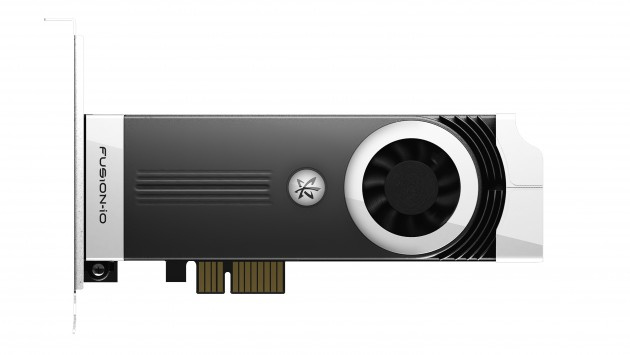The Company's ioFX Acceleration Is Also Coming to HP Z Workstations
Fusion-io has introduced a 1.6 TB version of its ioFX accelerator/storage device for 4K+ and stereo-3D productions that is expected to begin shipping this summer. It joins the 420 GB capacity version of the NAND flash memory-based, PCI Express-delivered device that connects the addressable memory of a storage drive with the processing power of CPUs and GPUs, pushing more high-resolution content to the acceleration it needs to perform at its peak.
At an NAB press conference keynoted by industry legend (and Apple co-founder) Steve Wozniak, the company's chief scientist, Fusion-io detailed its ioFX workstation acceleration platform roadmap and announced that the technology would also be integrated into future iterations of HP's Z820, Z620, and Z420 workstations. This will let editors, VFX artists, colorists and others in the DI pipeline work interactively and at full resolution on 2K, 4K, 5K and stereo-3D content without the latency and bottlenecks caused by legacy SSDs or SANs. The devices also target other time-intensive tasks such as encoding, transcoding, particle simulations, and working with excessive amounts of cached data.
Wozniak, the speed-talking, perpetually glass-half-full inventor of the personal computer, sees a parallel between his original concept for the Apple floppy disk and Fusion-io's product strategy. "In this case, I said, let's take the chips and plug them straight into the computer, like you would a disk drive. Then I said, let's make the computer memory the digital memory."
Wozniak thinks NAND flash memory will eventually replace long-term storage. "The bottleneck to speed during production and post is storage, and Fusion-io solves that," he said. Without the bottlenecks, he continued, CPUs and GPUs can operate at full capacity. "How did we make this happen?" Wozniak rhetorically asked the audience. "We're not a storage company and we don't have to worry about killing off our other storage devices. It took crossing a lot of different disciplines but, often, that's how great things get started."
Based on the Fusion-io Memory platform that already accelerates mountains of data in the oil and gas, medical, manufacturing and media markets, ioFX connects to workstations via PCI Express and appears as a disk drive on the computer screen. Reading NAND flash, said Fusio-io's director of visual computing, Vincent Brisebois, never wears it out, but writing to it eventually will. "The ioFX all come with a three-year warranty, but we've already seen some that have lasted five years or more," he said. "You can't get around the fact that they will eventually wear out, but as the cells map out, you never have to rebuild or remap. It just shuts itself down over time." Brisebois added that the technology works exceptionally well on powerful laptops; ioFX brings throughput speeds of 860 mb/s on a MacBook Pro with one Thunderbolt port and "lightning speeds with two ports," he said. "It runs great on the Mac, but also on the new HP laptops with Thunderbolt. Death to proxies: if you shoot in 4K, you should be able to edit and deliver in 4K, too."
Pricing on the devices is still to be determined. "These have a capacity four times the previous version," said Brisebois, "but they will not be four times the cost."
Crafts: Editing Post/Finishing VFX/Animation
Sections: Technology
Topics: New product CPUs Fusion-io gpus ioFX nab 2013 NAND flash
Did you enjoy this article? Sign up to receive the StudioDaily Fix eletter containing the latest stories, including news, videos, interviews, reviews and more.











Leave a Reply